
How Alibaba’s Taobao solved the trust problem in China and changed the way people shop
From humble beginnings as a local platform going up against then-incumbent eBay, Alibaba is now the clear leader in China’s vast US$1 trillion e-commerce market
Every month, some 634 million consumers – nearly half of China’s population – pull up Alibaba Group Holding’s Taobao Marketplace and Tmall e-commerce apps on their smartphones. Whether you are a farmer after crop fertiliser or a new homeowner looking to spend 18,000 yuan (US$2,630) on a 15-piece, Victorian-style furniture set, there is something for everyone.
In China, Alibaba has become synonymous with e-commerce, while its Taobao and Tmall platforms are household names. The Hangzhou-based firm, which is the parent company of the South China Morning Post, has a market capitalisation of about US$460 billion, making it the world’s second most valuable e-commerce company after Seattle-based Amazon.com.
The rapid ascent of Taobao – which translates to “searching for treasure” in Mandarin – and Tmall has helped nurture billion-dollar courier companies like SF Express and ZTO Express, which are capable of delivering packages from Shenzhen to Beijing in less than 24 hours. Taobao is Alibaba’s consumer-to-consumer platform, while Tmall is a business-to-consumer platform where brands sell directly to consumers.
On Thursday, Alibaba reported a 61 per cent increase in revenue to 80.9 billion yuan (US$11.8 billion) for the quarter ended June 30, driven by the company’s main e-commerce business even as it steps up investment in on-demand local services and other activities under its “New Retail” strategy.
“Our New Retail initiatives are substantially growing Alibaba’s total addressable market in e-commerce,” Joseph Tsai, executive vice-chairman at Alibaba, said in a conference call on Thursday. “Alibaba’s three-pronged consumer offering in retail, entertainment and local services will be the long-term drivers of value creation, as the Chinese middle class expands and more of these consumers demand a higher-quality lifestyle.”
Last year, China’s online sales crossed US$1 trillion for the first time, and the industry looks set for further growth. Only 11 per cent of the Chinese population has reached middle class, according to statistics from Goldman Sachs. As this number continues to grow, so will e-commerce sales.
From its humble beginnings as a local e-commerce platform going up against then-incumbent eBay, Alibaba is now the clear leader in China. Its domestic commerce businesses generated some 8.2 billion yuan, or about 67 per cent of its total revenue, according to its latest earnings result for the quarter ended June 30.
The company has a 58.2 per cent domestic market share in e-commerce, according to statistics from eMarketer, compared to its closest rival JD.com’s 16.3 per cent. Every year on November 11 Alibaba hosts Singles’ Day, the world’s largest online shopping festival, where merchants on its platforms offer massive discounts. Last year, US$25.3 billion worth of transactions were recorded, dwarfing the US$5 billion in sales from the Black Friday shopping day held in November in the US
Taobao and Tmall may be behemoths today, but when Alibaba founder Jack Ma Yun first had the idea to establish Taobao as a way to expand the company’s then business-to-business model to include consumers, the platform was seen as an underdog, a David compared to the Goliath that was eBay.
In the early 2000s, eBay was among the dominant e-commerce sites globally, with its online-auction model that allowed users to list items for sale. Then-eBay chief executive Meg Whitman had her sights trained on China, and in 2002 the US company bought a 33 per cent stake in Chinese auction site EachNet to give it a foothold in the market, before fully acquiring it a year later. At the time, EachNet already had significant market share in the consumer auction market in China and was the leading e-commerce site in China.
Ma figured that even though eBay positioned itself as a consumer site, it would eventually target Alibaba’s wholesalers, according to the book Alibaba’s World: How a Remarkable Chinese Company Is Changing the Face of Global Business, by Porter Erisman, a former Alibaba vice-president.
To counter that threat, Ma gathered a small team of Alibaba employees who agreed to work on the Taobao project. Those involved were sworn to secrecy – they had to resign from Alibaba and nobody could know what they were working on, not even their former colleagues or friends and family.
The Taobao team worked out of Ma’s old Hupan Gardens flat in Hangzhou – the same one in which he and 17 other founders first started Alibaba – and launched Taobao in secret in May 2003. To get the site going, each member had to produce four items to list on the site and purchase items from one another to give the impression that the site already had traffic and active users.
Our New Retail initiatives are substantially growing Alibaba’s total addressable market in e-commerce
Ma even listed his watch online, according to the book Alibaba: The House That Jack Ma Built by Duncan Clark. A Chinese longquan sword was also part of these “early” listings, and Taobao’s first ever transaction between a (real) buyer and seller saw a second-hand film camera change hands.
Unlike eBay’s EachNet, which pitted buyers against one another as they bid for items in an online auction, Taobao was launched as a consumer-to-consumer site where vendors could sell merchandise to users at fixed prices.
But what Taobao offered its shoppers was also a unique online shopping experience, modelled after offline wholesale markets. It introduced chat features that let buyers communicate directly with sellers, whether to haggle over prices or find out more about the product, and designed its site in a way that was appealing to its users. Listings were organised into categories like “men” and “women”, so at a click of a button users could see products that might appeal to them.
“Alibaba had looked to replicate the offline experience in shopping, by making Taobao the online manifestation of a sort of bazaar. They made that same investment in customer service on the platform … where customer service is part of the pre-purchase, during-purchase and post-purchase experience,” said Tom Birtwhistle, PwC Hong Kong digital consulting director.
“Alibaba has made online shopping fun, with videos, competitions, games on its e-commerce platforms. It became a fun place to shop and spend time, in the same way that going shopping offline is a fun experience.”
Another problem Taobao had to solve was that of trust. In a low-trust society like China, online transactions were difficult to complete because buyers did not know if sellers would actually send out the product once they received payment, nor were sellers willing to send out items until they received payment confirmation.

To solve that problem, Alipay was introduced in 2004 as an escrow service that would hold on to payments until the buyer had received their purchase before releasing the money to the seller. While Alipay has today evolved to become one of China’s most dominant third-party online payment platforms, where users can do everything from paying for Taobao and Tmall purchases as well as peer-to-peer money transfers, the origins of the service were humble and relied largely on manual efforts of employees. Alipay now operates under Alibaba affiliate Ant Financial Services.
When Alipay was first introduced, employees used fax machines to receive offline wire transfer confirmations from customers, and would manually record any abnormal bank payments in a notebook, according to Alibaba.
Alipay, which eventually became more sophisticated and automated, was a game changer for the Taobao platform, allowing its users to have the trust that they would not be cheated when using the platform.
One of the biggest factors that gave Taobao an edge in China at that time was that it was a free-to-use services. That was in contrast with eBay’s EachNet, which was charging sellers fees for each transaction and listing.
Alibaba also benefited by eBay’s missteps with EachNet in China – including the migration of servers from China to the US that resulted in slow, unreliable service, as well as the decision to unify EachNet’s interface with eBay’s clean, minimalist one, much to the disappointment of users. As a result, people started leaving the EachNet platform in droves, with many sellers deciding to list instead on Taobao, whose website was both free and aesthetically pleasing to Chinese users who preferred colourful images and pop-ups scattered throughout the site.

By 2004, Taobao had already captured nearly a 60 per cent domestic market share. Four years later, it was the clear leader with nearly 84 per cent of the market, compared to EachNet’s 7.2 per cent. By then, eBay had already shut down its Chinese site, making the decision to partner with Chinese firm Tom Online to relaunch the EachNet site.
California-based eBay did not immediately respond to an emailed request for comment. Alibaba did not make its Taobao executives available to interview for this story and did not provide a comment.
“The initial success of Taobao was as much due to the failure of EachNet and eBay’s American management teams, as to the success and savviness of the Alibaba management team,” said Shaun Rein, the managing director of China Market Research Group and author of The War for China’s Wallet: Profiting from the New World Order.
“A lot of Americans complain that Western tech companies cannot succeed in China because of the government, but in fact a lot of the failures were due to the management teams, from eBay to Google.”
For e-commerce companies like Alibaba, the industry today remains a greenfield of opportunity. As China’s growing middle class becomes more affluent, many are turning to e-commerce platforms like Tmall and JD.com for more expensive foreign products, such as infant milk powder and cosmetics.
In rural areas and lower-tier cities where there are fewer shopping malls compared to big cities like Beijing and Shanghai, e-commerce gives residents a wider range of choice and are set to become the next engine of online growth for companies like Alibaba and JD.com. Both companies have implemented rural e-commerce initiatives, including investing in logistics infrastructure, exploring drones as a delivery solution for remote regions, and encouraging rural Chinese users to sell their wares on the platform as the country becomes the world’s largest smartphone and mobile internet market.
Liu Qing¸ a 23-year-old car salesman from a rural town in Shandong province, said the popularity of Taobao and Tmall has greatly changed the way he shops.
“When I was young, our family had to travel to Qingdao to purchase branded products because that was the nearest big city offering a wide product range in the shopping malls,” Liu said. “But nowadays, even if I don’t leave my house, I can purchase almost anything I want on Taobao as long as I can afford to.”
But the days when Taobao and Tmall remain solely e-commerce platforms may be numbered. Over the past two years, Alibaba has been moving towards its “New Retail” strategy to meld online and offline shopping experiences across its ecosystem of services, be it grocery shopping, food delivery or local services.
Taobao and Tmall could soon offer on-demand delivery services via its food delivery unit Ele.me, according to Ele.me chief executive Wang Lei. This Alibaba subsidiary has a fleet of three million deliverymen, representing a resource that would help expand Alibaba’s on-demand logistics capabilities, allowing users to receive orders within hours if they purchase from a merchant who is based in the same city.
The on-demand local services market “is a must-win and must-have” for Alibaba, said Maggie Wu Wei, the company’s chief financial officer, at the conference call on Thursday.
“As China consumers demand more quality and diversity of services, this category represents a massive trillion dollar opportunity,” Wu said.


